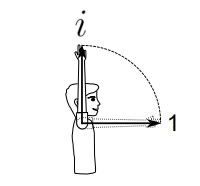Observing imaginary numbers in our daily life
The imaginary unit acts as both an orthogonal rotation generator for rotating vectors and a unit vector for pointing to a direction orthogonal to a reference direction.

A person points his arm horizontally forward, and then rotates and points the arm vertically upward, with the imaginary unit i representing the unit vector for the resultant vertical direction. Here, the initial horizontal direction with the associated vector length (from shoulder joint to pointer fingertip) is assigned as the unit vector 1.

In the x-y plane that directly connects to real life, number 1 in the x-axis implies a direction relative to the origin and is considered as a unit vector for the x-axis direction. Through multiplication, the unit vector 1 is rotated by the orthogonal rotation generator i and becomes the unit vector i for the y-axis direction. In practice, the directions of the unit vectors are implied. The unit vector 1 is replaced with number 1, and the unit vector i is replaced with the imaginary unit i. But, in our mind, we still consider number 1 as x-axis unit vector and i as y-axis unit vector.